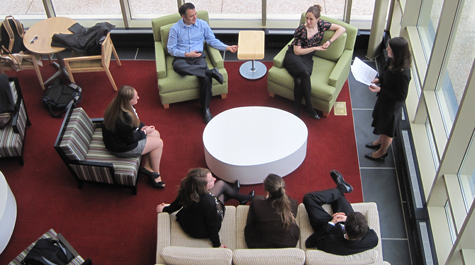PIPS and CIA present crisis simulation competition
The Central Intelligence Agency joined forces with William & Mary’s Project on International Peace and Security (PIPS) to conduct the first-ever Crisis Simulation Competition, described as “a Model U.N. for the intelligence community.”
A number of CIA personnel came to campus for the Feb. 7 event, held in rooms in the Sadler Center and the Cohen Career Center. In addition to William & Mary, participants in the crisis simulation came from Norfolk State, Sweetbriar College, the University of Mary Washington, the University of Richmond, Washington College, Old Dominion University and Virginia Tech.
“Usually the CIA will do a simulation two or three times a year with just a single school,” Dennis Smith explained. “We proposed to them a competition-type simulation involving multiple schools. It was kind of like a Model UN for the intelligence community. They loved the idea and brought us a new scenario.”
Smith is visiting assistant professor of government at William & Mary. He and Amy Oakes, assistant professor of government, are co-directors of PIPS—an elite program that draws on high-performing students from the College’s government, public policy and international relations programs into what Smith and Oakes call “an undergraduate think tank” to grapple with sensitive and important global issues.
Each five-person team was presented with the CIA-authored scenario: Printouts containing raw intelligence surrounding a fictitious—but plausible—developing international crisis. They had three hours to sort through the information and prepare a cogent half-page brief outlining the situation and suggesting a course of action for the United States.
Members of the William & Mary team were Emily Pehrsson ’13, Julia Zamecnik ’11, William Shimer ’13 and Lindsay Hundley ‘12. Each team had a CIA mentor.
“The mentor did not lead,” Smith said. “The mentor was there to observe and provide suggestions.”
At the end of the simulation, the analysts reviewed the written briefs from all eight teams. The top two teams in each group engaged in a “brief-off” in front of the entire CIA contingent. The winner was declared to be the team from Norfolk State, and Smith points out that the experience was more about the simulation than the competition.
“It wasn’t designed a recruiting event. It was designed to be an educational event,” Smith said. “It was designed to teach analytical skills and the importance of knowing how to deliver a brief. I talked to students from all the schools. They all said that it was the most intense experience that they’ve ever had. One student told me that he felt like his brain was going to explode with all the facts he had to juggle in his head.”
 Skip to main content
Skip to main content

